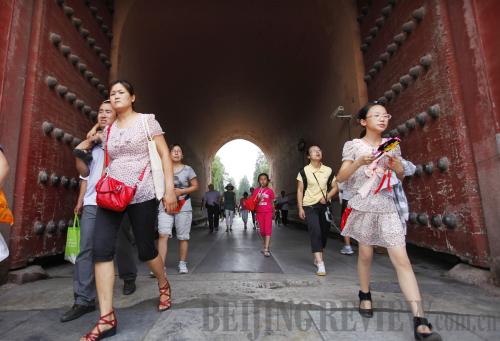|
 |
|
A MUST-SEE SITE: Visitors walk out of the Palace Museum's Donghua Gate on July 20 (WAN XIANG) |
The Palace Museum
The Palace Museum was established in 1925. The magnificent architecture, also known as the Forbidden City, and the vast holding of the imperial collections of paintings, calligraphy, ceramics, and decorative objects make it one of the most prestigious museums in China and the world. In 1961 the imperial palace was designated by the State Council as one of China's foremost-protected cultural heritage sites, and in 1987 was made a UNESCO World Heritage site.
According to an inventory of the museum's collection conducted between 2004 and 2010, the Palace Museum holds a total of 1,807,558 artifacts and includes 1,684,490 items designated as nationally protected "valuable cultural relics."
(Source: The Palace Museum)
Woes in the Palace Museum
Around midnight on May 8, nine purses and jewellery boxes on loan from a private Hong Kong museum were stolen by a single thief who dug his way past the Palace Museum's 240 guards, 3,700 cameras and 1,600 anti-theft alarms. A suspect was arrested by the police on May 11 and is being questioned prior to a public prosecution.
On May 11, Rui Chenggang, a prominent anchor on national broadcaster CCTV, alleged on his blog that one of the buildings inside the Palace Museum—the 269-year-old Jianfu Hall—had been converted into a private establishment for "the 500 richest people in the world." The museum denied the existence of a VIP club, but acknowledged that the Jianfu Hall, which is in an area closed to the general public, is mainly used to receive "distinguished guests from home and abroad."
On July 30, a blogger, known as Longcan, accused a worker at the Palace Museum of breaking a priceless porcelain plate dating back to the Song Dynasty (960-1279). Longcan alleged that both the worker and the Palace Museum attempted to cover up the accident. On July 31, the Palace Museum admitted that a dish belonging to the museum's porcelain collection was damaged while it was being subject to testing.
On August 5, Internet users discovered that five Song Dynasty letters, reportedly purchased by the Palace Museum in 1997, were sold at three times the price at which they were purchased in a 2005 auction. The museum claimed that the initial sale never went through (and therefore that it never owned nor resold the letters), although the 1997 purchase of the documents is "mistakenly" included by staff in a book on the museum's history.
On August 9, the Caixin New Century magazine reported that tour guides and Palace Museum staff were bringing thousands of tourists into the museum through a side door and pocketing their ticket money. Caught on video in 2009, the ringleaders of the scam offered 200,000 yuan ($31,262) to try and keep the scandal out of the media.
On August 17, a former Bank of China official accused the Palace Museum of not paying taxes on ticket revenues from exhibitions held outside the main gate. The museum responded that the exhibitions were not held under its administration, but an article in the Beijing-based Global Times quotes a lawyer as saying the museum's principle manager could face up to seven years in jail if the tax-evasion allegations are proven.
On August 18, someone claiming to be a Palace Museum employee sent a letter to the Beijing Times newspaper, saying that more than 100 rare books have gone missing from the Palace Museum's collection and that staff have been instructed not to investigate where they are or how they could have been lost. In response, the museum admitted that "by 2009, more than 100 out of 200,000 volumes could not be accounted for. The inventory has not been completed as yet so these books can still not be firmly identified as lost." | 